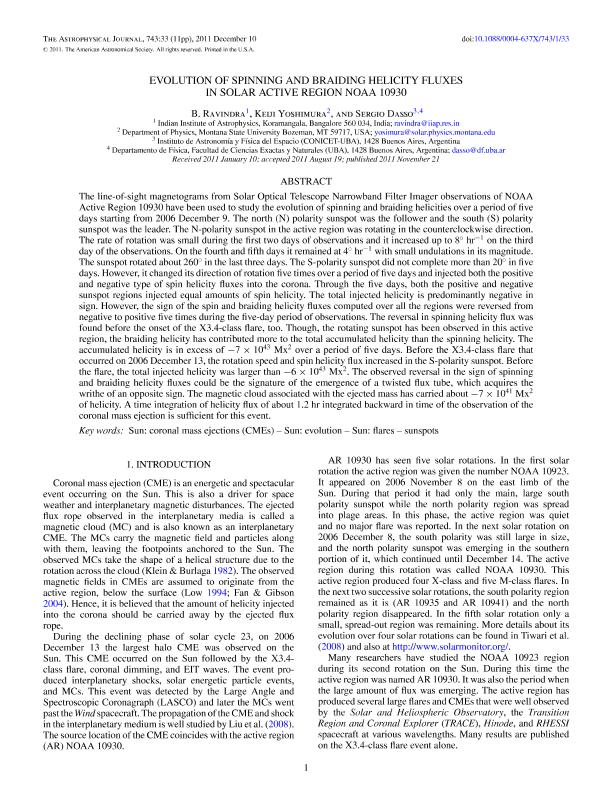Mostrar el registro sencillo del ítem
dc.contributor.author
Ravindra, B.
dc.contributor.author
Yoshimura, Keiji
dc.contributor.author
Dasso, Sergio Ricardo

dc.date.available
2019-05-21T13:52:43Z
dc.date.issued
2011-12
dc.identifier.citation
Ravindra, B.; Yoshimura, Keiji; Dasso, Sergio Ricardo; Evolution of spinning and braiding helicity fluxes in solar active region NOAA 10930; IOP Publishing; Astrophysical Journal; 743; 1; 12-2011; 33-44
dc.identifier.issn
0004-637X
dc.identifier.uri
http://hdl.handle.net/11336/76772
dc.description.abstract
The line-of-sight magnetograms from Solar Optical Telescope Narrowband Filter Imager observations of NOAA Active Region 10930 have been used to study the evolution of spinning and braiding helicities over a period of five days starting from 2006 December 9. The north (N) polarity sunspot was the follower and the south (S) polarity sunspot was the leader. The N-polarity sunspot in the active region was rotating in the counterclockwise direction. The rate of rotation was small during the first two days of observations and it increased up to 8°hr-1 on the third day of the observations. On the fourth and fifth days it remained at 4°hr-1 with small undulations in its magnitude. The sunspot rotated about 260° in the last three days. The S-polarity sunspot did not complete more than 20° in five days. However, it changed its direction of rotation five times over a period of five days and injected both the positive and negative type of spin helicity fluxes into the corona. Through the five days, both the positive and negative sunspot regions injected equal amounts of spin helicity. The total injected helicity is predominantly negative in sign. However, the sign of the spin and braiding helicity fluxes computed over all the regions were reversed from negative to positive five times during the five-day period of observations. The reversal in spinning helicity flux was found before the onset of the X3.4-class flare, too. Though, the rotating sunspot has been observed in this active region, the braiding helicity has contributed more to the total accumulated helicity than the spinning helicity. The accumulated helicity is in excess of -7 × 1043Mx2 over a period of five days. Before the X3.4-class flare that occurred on 2006 December 13, the rotation speed and spin helicity flux increased in the S-polarity sunspot. Before the flare, the total injected helicity was larger than -6 × 1043Mx2. The observed reversal in the sign of spinning and braiding helicity fluxes could be the signature of the emergence of a twisted flux tube, which acquires the writhe of an opposite sign. The magnetic cloud associated with the ejected mass has carried about -7 × 1041Mx2 of helicity. A time integration of helicity flux of about 1.2hr integrated backward in time of the observation of the coronal mass ejection is sufficient for this event. © 2011. The American Astronomical Society. All rights reserved.
dc.format
application/pdf
dc.language.iso
eng
dc.publisher
IOP Publishing

dc.rights
info:eu-repo/semantics/openAccess
dc.rights.uri
https://creativecommons.org/licenses/by-nc-sa/2.5/ar/
dc.subject
Sun: Coronal Mass Ejections (Cmes)
dc.subject
Sun: Evolution
dc.subject
Sun: Flares
dc.subject
Sunspots
dc.subject.classification
Astronomía

dc.subject.classification
Ciencias Físicas

dc.subject.classification
CIENCIAS NATURALES Y EXACTAS

dc.title
Evolution of spinning and braiding helicity fluxes in solar active region NOAA 10930
dc.type
info:eu-repo/semantics/article
dc.type
info:ar-repo/semantics/artículo
dc.type
info:eu-repo/semantics/publishedVersion
dc.date.updated
2019-05-14T21:19:23Z
dc.journal.volume
743
dc.journal.number
1
dc.journal.pagination
33-44
dc.journal.pais
Reino Unido

dc.journal.ciudad
Londres
dc.description.fil
Fil: Ravindra, B.. Indian Institute Of Astrophysics; India
dc.description.fil
Fil: Yoshimura, Keiji. Montana State University; Estados Unidos
dc.description.fil
Fil: Dasso, Sergio Ricardo. Consejo Nacional de Investigaciónes Científicas y Técnicas. Oficina de Coordinación Administrativa Ciudad Universitaria. Instituto de Astronomía y Física del Espacio. - Universidad de Buenos Aires. Facultad de Ciencias Exactas y Naturales. Instituto de Astronomía y Física del Espacio; Argentina. Universidad de Buenos Aires. Facultad de Ciencias Exactas y Naturales. Departamento de Física; Argentina
dc.journal.title
Astrophysical Journal

dc.relation.alternativeid
info:eu-repo/semantics/altIdentifier/doi/http://dx.doi.org/10.1088/0004-637X/743/1/33
Archivos asociados
